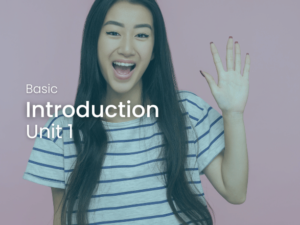Unidad 5: Asuntos de Familia (Básico)
- Descripción
- Currículum
- FAQ
- Notice
- Reseñas

La Lección Básica de Asuntos Familiares está diseñada para estudiantes principiantes que quieren construir una comprensión básica de cómo hablar de la familia en español. Este curso se centra en el vocabulario esencial y en estructuras oracionales sencillas que te ayudarán a presentar a los miembros de tu familia, describir relaciones y hablar de actividades familiares básicas.
Beneficios del curso:
- Vocabulario básico:
Aprende las palabras más importantes para referirse a los miembros de la familia (por ejemplo, madre, padre, hermano, hermana) y frases básicas para describir relaciones y estructuras familiares. - Lecciones fáciles de seguir:
Cada lección se divide en pasos sencillos y digeribles, por lo que es fácil de seguir y comprender para los principiantes. - Conversaciones de la vida real:
Practica el uso de frases básicas relacionadas con la familia en conversaciones cotidianas, como presentar a tu familia, preguntar por la familia de alguien y describir los roles familiares. - Perspectivas culturales:
Descubra cómo funcionan las dinámicas familiares en las culturas hispanohablantes, lo que te proporcionará el contexto cultural necesario para comprender cómo interactúan y se comunican las familias. - Aprendizaje interactivo:
Con una gran variedad de divertidos ejercicios, cuestionarios y clips de audio, podrás reforzar tu aprendizaje y practicar la pronunciación.
Este curso es ideal para principiantes absolutos que quieren empezar a hablar español aprendiendo a hablar de sus familias en conversaciones comunes.
-
2Grammar Practice. The verb 'Estar' y 'Ser'
-
3Grammar Practice. Discovering My Family: Question and Answer Activity” - Use of the verb ‘tener’ (to have)Instructions: 1. Examine the family tree. Carefully study/review Mateo’s family tree. Pay attention to the names and family relationships shown. 2. Read the questions. You will find a series of questions about Mate’s family. 3. Answer Using Complete sentences. For each question, write your answer in a complete sentence. Make sure to include enough information so your response is clear
-
4Proofreading and Conjugation Practice: Improve your Spanish SkillsInstructions: 1. Fill the blanks Below are sentences with missing verbs. Your task is to fill in each blank with the correct conjugation of “tener”, “ser” , or estar.” 2. Complete Each Sentence Carefully read each sentence and think about which verb fist best. Write your answer in the blank provided.
-
5Possesive Adjectives. Building SentencesMatch the word with its sentence
-
6Vocabulary Practice. La FamiliaInstructions 1. Flash cards, get both meanings together 2. Fill the gap with the correct word based on the picture
-
7Vocabulary Practice. Adjectives that describe appearanceInstructions 1. First, take a look at the image provided in either Spanish or English. 2. Then, translate the word from the image into English or Spanish.
-
8Vocabulary Practice. Adjectives that describe personalityInstructions 1. First, take a look at the image provided in either Spanish or English. 2. Then, translate the word from the image into English or Spanish.
-
9Vocabulary Practice. Adjectives for feelings of stateInstructions 1. First, take a look at the image provided in either Spanish or English. 2. Then, translate the word from the image into English or Spanish.
-
10Vocabulary Practice. Nouns to describe appearanceInstructions 1. Get ready You will need colored pencils for this activity 2. Steps: First, look at the word given in Spanish or English Next, color the word using the correct color ( the word will tell you which color to use). Finally, translate the word into English or Spanish.
-
11Vocabulary Quiz. La Familia
-
12Practice Exercise. Possessive Pronouns and Adjectives in SpanishInstruccions: Read the Sentences Look at the sentence provided. Choose the Correct Adjective Complete the sentence with the appropriate possessive adjective. ¿Dónde está tu mochila? (your)
-
13Reading Comprehension Activity. Use of Verbs “Ser”, “Estar” and “Estar”. Estar”, ‘Estar’ and ‘Tener’Instructions: 1. Read the Sentences: Start by carefully reading the sentences provided to you. Pay attention to the context to understand which verb is the most appropriate. 2. Fill in the blanks: Complete the sentences by filling in the blanks with the correct form of the verb ‘ser’, “estar”, or “tener”. Make sure that the verb you choose agrees with the subject of the sentence and conveys the intended meaning. 3. Answer the comprehension questions: After completing the sentences, you will answer a series of questions related to the text. These questions will help you
-
14Quiz Verb Ser
-
15Quiz Verb Tener
-
16Quiz Verb EstarLook at the images and the subject pronoun provided. Then, write a sentence in Spanish describing how each person is feeling right now. Make sure to use the verb “Estar” correctly!
-
17Quiz Ser, Estar, and Tener
-
18Quiz Possessive adjectivesFill in the blank with the correct possessive adjective. Choose the right option to complete the sentence!
Notice
- Nuevo cuestionario interactivo:
Pon a prueba tus conocimientos con nuestro nuevo «Test de vocabulario familiar», que te ayudará a reforzar lo aprendido en la lección. - Paquete especial:
Inscríbete este mes para recibir el paquete completo de cursos de la Unidad 5. - Sesión de prácticas en directo:
No te pierdas nuestras sesiones en directo en las que practicaremos la presentación de nuestras familias en español. Esta es una gran oportunidad para mejorar tus habilidades orales en un ambiente de apoyo.
Este curso proporciona una introducción fácil para principiantes a la discusión de asuntos familiares en español, a la vez que destaca las características y ventajas clave del curso, junto con una variedad de experiencias para el alumno. Vocabulario familiar y descripciones básicas de los miembros de la familia.




